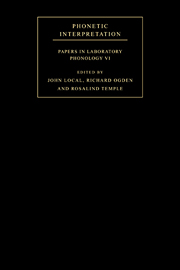Book contents
- Frontmatter
- Contents
- List of contributors
- Acknowledgements
- Introduction
- Part I Phonological representations and the lexicon
- Part II Phonetic interpretation and phrasal structure
- Part III Phonetic interpretation and syllable structure
- Part IV Phonology and natural speech production: tasks, contrasts and explanations
- 16 The interaction of the phonetics and phonology of gutturals
- 17 Pitch discrimination during breathy versus modal phonation
- 18 The phonetic interpretation of register: evidence from Yorùbá
- 19 Speech rhythm in English and Japanese
- 20 Commentary: on the interpretation of speakers' performance
- References
- Index of names
- Index of subjects
20 - Commentary: on the interpretation of speakers' performance
Published online by Cambridge University Press: 22 September 2009
- Frontmatter
- Contents
- List of contributors
- Acknowledgements
- Introduction
- Part I Phonological representations and the lexicon
- Part II Phonetic interpretation and phrasal structure
- Part III Phonetic interpretation and syllable structure
- Part IV Phonology and natural speech production: tasks, contrasts and explanations
- 16 The interaction of the phonetics and phonology of gutturals
- 17 Pitch discrimination during breathy versus modal phonation
- 18 The phonetic interpretation of register: evidence from Yorùbá
- 19 Speech rhythm in English and Japanese
- 20 Commentary: on the interpretation of speakers' performance
- References
- Index of names
- Index of subjects
Summary
Introduction
This commentary highlights three related issues arising from the papers by Zawaydeh, Silverman, Hayward, Watkins and Oyètádé, and Tajima and Port:
(a) to what extent do these findings shed light on the characteristics of phonetic interpretation in natural speech production?
(b) how reliable are arguments which are founded on the view that the predominant influence on the vocal tract in speech production is a pressure to differentiate hypothesised contrasting phonological categories acoustically, auditorily or articulatorily?
(c) how explicit are we about how we conceive of the relationship between hypothesised features/structures and their phonetic correlates; in particular what is the burden of proof in respect of the phonetic observations which are required to postulate the existence of a particular feature, and what does the hypothesis of the existence of a particular feature predict about its phonetic correlates?
These questions are fundamental to the interpretation of the results of these papers, but are not explicitly addressed. The present investigators, however, are far from being alone in skirting around some of these areas or leaving their understanding of them implicit (and it does not seem to be that this is because the issues concerned are uncontroversial). Given the current diversification in laboratory phonology, both methodologically and in the range of theoretical perspectives which are being brought to bear in investigating the phonetic interpretation of phonological categories, it seems particularly important that underlying issues and assumptions such those in (a)–(c) are brought into view and reflected upon.
- Type
- Chapter
- Information
- Phonetic InterpretationPapers in Laboratory Phonology VI, pp. 340 - 354Publisher: Cambridge University PressPrint publication year: 2004



